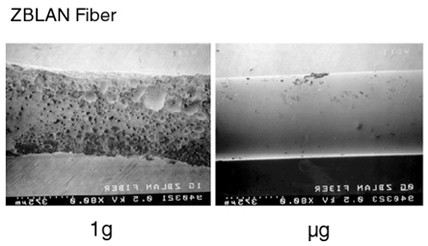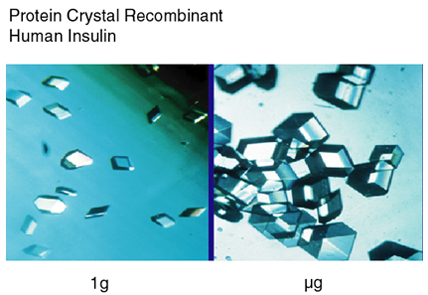Tutorial on Microgravity Research
Comparison Photograph's Showing Materials Produced in Microgravity vs. Materials Produced in Earth Gravity
Why Microgravity Research?
One of the most promising new areas for the commercialization of space is in the field of microgravity. Microgravity is the absense of gravity also known as weightlessness or zero gravity. It is most dramatically illustrated by astronauts floating around in their spacecrafts. Microgravity allows new materials to be developed which can not be made on Earth due to gravity. These new materials can be used to speed up future computers, reduce pollution, improve fiber optics, and enable medical break throughs to cure diseases.
Look at the comparisons below. The same magnification is used for the comparisons. Can you guess which ones were processed on Earth and which ones in microgravity? (Hint: if it looks "bigger and better", it was processed in microgravity!)
Comparison images provided by NASA.

Marshall Space Flight Center's researchers have conducted suborbital experiments with ZBLAN, an optical material capable of transmitting 100 times more signal and information than silica fibers. The next step is to process ZBLAN in a microgravity
environment to stop the formation of crystallites, small crystals caused by a chemical imbalance. Scientists want to find a way to make ZBLAN an amorphous (without an internal shape) materials. Producing a material such as this will have far reaching implications on adavanced communications, medical and manufacturing technologies using lasers, and a host of other products well into the 21st century.

Improved crystals of human insulin will help improve treatment for diabetes and potentially creat a cure. Recombin Human insulin facilitates the incorporation of glucose into cells. In diabetics, ther is either a dercrease in or complete lack of insulin, thereby leadihng to several harmful complications.
Crystals grown in microgravity are larger and of greater optical clarity than cyrstals grown on Earth. Diabetes costs the U.S. $98 billion annually. It is our single most costly diisease. The average life time cost of diabetes care for a person diagnosed at age 3 is $600,000. Diabetes is the leading cause of blindness and kidney failure. New cases of diabetic blindness and kidney failure increase the cost of diabetes by $1.5 billion annually. Diabetic amputations increase the economic toll of the disease by more than $1.5 billion per year. And the best way to manage diabetes is to CURE IT. (Source: Fast Track to a Cure Foundation)


|
